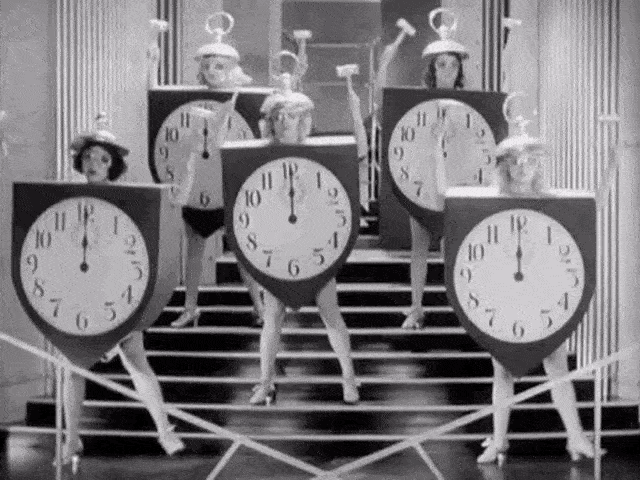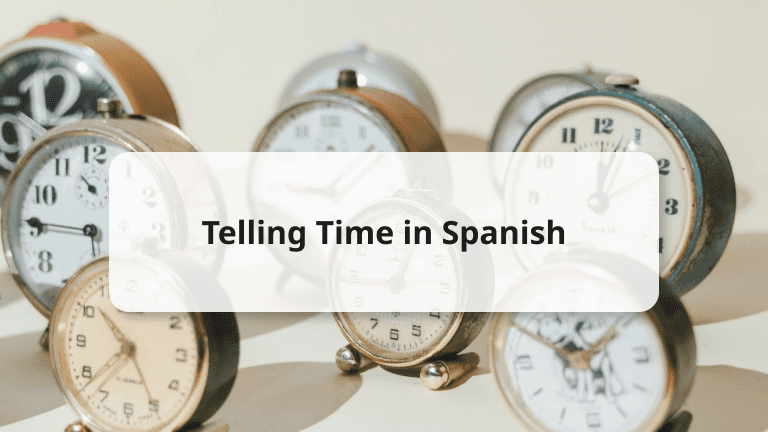Being able to tell the time in Spanish, will save you late trips and embarrassment. Although most Spanish countries have come to be known as countries with a rather unhurried and relaxed culture, it’s still important to be able to get where you need to be on time. Being able to do so will ensure that you’re never late for that business meeting or lunch date with a new friend. Even though learning to understand time in Spanish could seem daunting, you shouldn’t worry: by the end of this article, you will have a better grasp and understanding of how to tell time in Spanish while participating in some fun quizzes along the way to help you keep track of your new found knowledge and realize whether Spanish is hard to learn.
¿Qué hora es? – What time is it
One of the most common and colloquial ways to ask for the time in a conversation in Spanish is “¿Qué hora es?” Literally, this question translates to “What hour is it?” However, another common example of telling time in Spanish would be “¿A qué hora es?” which translates to “At what time”. Both questions are useful in different circumstances when it comes to the classic “¿Qué hora es?” it should only be used with the Spanish verb “Ser” and should be used when directly asking someone what the time is at that moment. ¿A qué hora es?” is used to identify the time a specific action or event is taking place.
| Spanish | English |
| ¿Qué hora es, Daniel? 🎧 | What time is it, Daniel? |
Another way in which you could ask for the time would be “¿Tiene hora?” this question literally translates to “Do you have time?” this example can be used when asking a stranger if they could tell you the time.
| Spanish | English |
| Discúlpeme, ¿tiene hora, por favor? 🎧 | Excuse me, do you have time, please? |
Expressing Hours in Spanish
In Spanish when it comes to expressing time, the verb “Ser” is commonly used, this verb directly translates to “To be”. Those who are unclear on how to conjugate this verb are encouraged to watch this video.
When using the verb Ser, a simple formula should be followed to express time:
Verb Ser (third person singular) + las(feminine definite article) + Current Hour (feminine) |
In this case, “Ser” should always be used before the time and will always be “Son” except for when the time in question being given has a single hour such as saying “One o’clock”, in which case it would be “Es”. These are usually used in conjunction with the feminine article “la/las” which always goes before the number. Again, “Las” will always be used unless the hour is singular such as saying “One o’clock” in which case “la” should be used instead.
| Spanish | English |
| Es la una | It’s one o’clock |
| Son las cuatro | It’s four o’clock |
Remember that Spanish is a gendered language which is why time is always expressed as feminine. When telling the time in Spanish “Las” should always be the primary article used as it refers to “la hora”. The only time during which this is not the case would be when the number in question is singular such as saying “one o clock”, then “la” should be used.

Asking When an Event Starts
When it comes to asking at what time a specific event starts, different rules might apply, this makes it important to understand what to ask and when. When discussing when an event begins or starts it’s important to be familiar with the verbs “Comenzar and Empezar”. While both are used to begin/start something, there are still specific situations in which each is best used, to better understand how to conjugate these verbs watch the video linked in this section.
However, for those who are familiar with conjugating empezar the sentence structure would be fairly easy to understand. When asking when an event starts, a simple formula for the sentence structure can be used, namely:
Cuando (when) + empieza/comienza (3rd person singular) + determinative article (el, la) + Event |
| Spanish | English |
| ¿Cuándo empieza el evento? 🎧 | When does the event start? |
| Por favor dime cuando comienza el show. 🎧 | Please tell me when the show begins |
| Spanish | English | Audio Translation |
| Es la una | It’s one’o’clock | 🎧 |
| Son las dos | It’s Two o clock | 🎧 |
| Son las tres | It’s three o clock | 🎧 |
| Son las cuatro | It’s four o clock | 🎧 |
| Son las cinco | It’s five o clock | 🎧 |
| Son las seis | It’s six o clock | 🎧 |
| Son las siete | It’s seven o clock | 🎧 |
| Son las ocho | It’s eight o clock | 🎧 |
| Son las nueve | It’s nine o clock | 🎧 |
| Son las diez | It’s ten o clock | 🎧 |
| Son las once | It’s eleven o clock | 🎧 |
| Son las doce | It’s twelve o clock | 🎧 |
Expressing Hours + Minutes in Spanish
When learning to understand the time in any language it’s important to understand the specifics of differentiating between the minutes and hours as this plays a crucial role. However, there is no need to fret, learning to understand the difference between hours and minutes is quite similar to learning to express the difference hours in Spanish. In this instance, the only major difference is an extra “y” (and) + minutes (number) at the end of the phrase.
The easiest way to express the hours and minutes in Spanish follows this formula
Es/Son (depends if singular/plural) + la/las (depends if singular/plural) + hour + number of minutes |
| Spanish | English |
| Es la una y cuarenta 🎧 | It’s one forty |
| Son las dos y media 🎧 | It’s half past two |
| Son las dos y cuarto 🎧 | It’s a quarter past two |

AM or PM
Although in the English language AM and PM are frequently used, this is not the case with Spanish, usually, instead, a 24-hour notation is used in formal Spanish and in less formal Spanish usually a 12-hour notation is kept in which case “De la mañana” would be used in the morning and “De la noche” would be used in the evening.
Example:
| Spanish | English |
| Son las ocho de la mañana 🎧 | It’s eight in the morning |
| Son más de las cinco de la mañana. 🎧 | It’s after five am |
| Nosotras deberíamos irnos después de las diez de la noche. 🎧 | We should leave after ten pm |
12h clock vs 24h clock
As previously stated, in Spanish the shorthand AM and PM are not commonly used, instead, a 24 and 12-hour clock is used. For the 12 hour system, the phrases “ de la mañana” (AM), “de la tarde” and de la noche” are used with the last two being used in reference to PM. However, for the 24-hour system these phrases are not used and instead the number of minutes is expressed by using a full number.
12-hour clock
| Spanish | English |
| La película comienza a las cinco de la tarde 🎧 | The film starts at five pm |
| Vamos a bailar hasta la medianoche 🎧 | We’re going dancing until midnight |
24-hour clock
| Spanish | English |
| El espectáculo comienza quince minutos después de las dos 🎧 | The show starts at fifteen minutes after two |
| Por favor esté allí a las 5 de la tarde 🎧 | Please be there at 5 in the evening |

Time in Spanish (Useful Phrases)
There are many useful phrases to learn when saying the time or months in Spanish. Here are 10 common and useful phrases:
| Spanish | English | Audio Translation |
| En la mañana | In the morning | 🎧 |
| Al medio día | At midday | 🎧 |
| En la tarde | In the afternoon | 🎧 |
| En la noche | In the night time | 🎧 |
| A la medía noche | At midnight | 🎧 |
| ¿A qué hora? | At what time? | 🎧 |
| ¿Tienes tiempo? | Do you have the time? | 🎧 |
| Empiezo mi día a las ocho de la mañana | I start my day at 8 AM | 🎧 |
| ¿Cuándo comienza la lección? | When does the lesson start? | 🎧 |
| Avísame cuando comience el espectáculo | Let me know when the show starts. | 🎧 |

¡Nunca es Tarde para Empezar! – It’s Not too Late to Start!
Now that you have a better understanding of the different ways to tell the time in Spanish and how to structure these sentences, we hope you’ll be able to better navigate the next time you are practicing the language. Remember that telling time and being able to ask for the time is a very useful skill to have especially when visiting foreign countries. Being able to tell the time will keep you from running late and allow you to help others when they need the time. For those who are interested in learning about time in other languages, keep reading here to learn time in French or time in Korean.
Connect with one-on-one Spanish tutors with AmazingTalker!
















